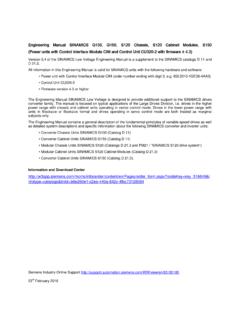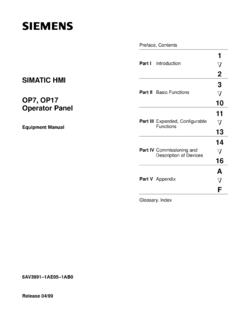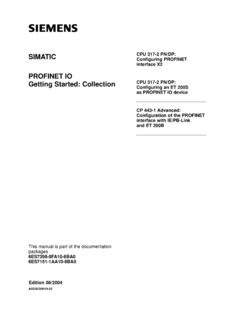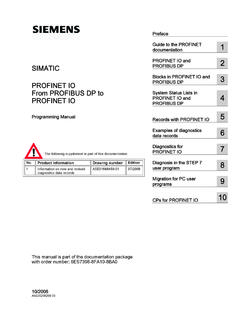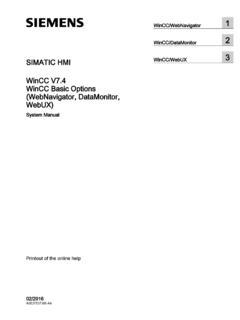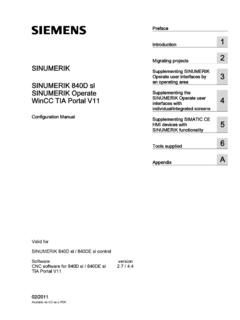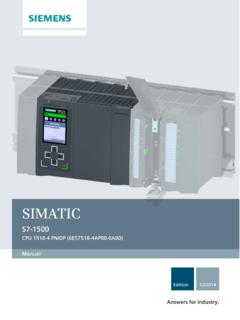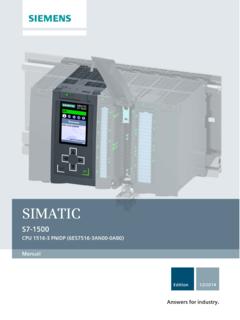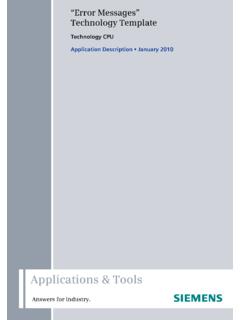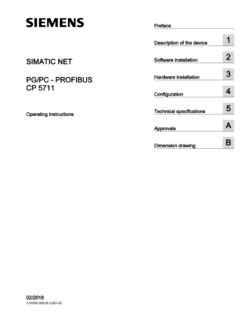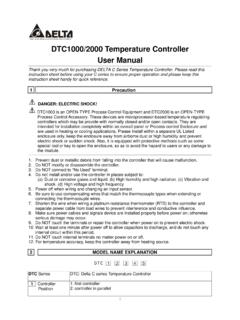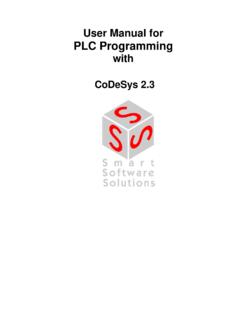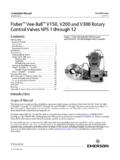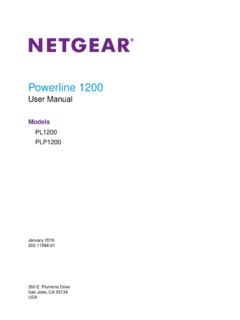Transcription of Introducing the Product and Installing 1 Installation 2 ...
1 S Preface Contents Introducing the Product and Installing the Software 1 Installation 2 Working Out the Automation Concept3 Basics of Designing a Program Structure 4 Startup and Operation 5 Setting Up and Editing the Project 6 Editing Projects with Different Versions of step 7 7 Defining Symbols 8 Creating Blocks and Libraries 9 Creating Logic Blocks 10 Creating Data Blocks 11 Parameter Assignment for Data Blocks 12 Creating STL Source Files 13 Displaying Reference Data 14 Checking Block Consistency and Time Stamps as a Block Property 15 Configuring Messages 16 Controlling and Monitoring Variables 17 Establishing an Online Connection and Making CPU Settings 18 Downloading and Uploading 19 Testing with the Variable Table 20 Testing Using Program Status 21 Testing using the Simulation Program (Optional Package) 22 Diagnostics 23 Printing and Archiving 24 Working with M7 Programmable Control Systems 25 SIMATIC Programming with step 7 manual This manual is part of the documentation package with the order number: 6ES7810-4CA08-8BW0 Tips and Tricks 26 Appendix A Edition 03/2006 A5E00706944-01 Index Siemens AG Automation and Drives Postfach 4848 90437 N RNBERG GERMANY A5E00706944-01 03/2006 Copyright Siemens AG 2006 Technical data subject to change Safety Guidelines This manual contains notices you have to observe in order to ensure your personal safety, as well as to prevent damage to property.
2 The notices referring to your personal safety are highlighted in the manual by a safety alert symbol, notices referring to property damage only have no safety alert symbol. The notices shown below are graded according to the degree of danger. ! Danger indicates that death or severe personal injury will result if proper precautions are not taken. ! Warning indicates that death or severe personal injury may result if proper precautions are not taken. ! Caution with a safety alert symbol indicates that minor personal injury can result if proper precautions are not taken. Caution without a safety alert symbol indicates that property damage can result if proper precautions are not taken. Notice indicates that an unintended result or situation can occur if the corresponding notice is not taken into account. If more than one degree of danger is present, the warning notice representing the highest degree of danger will be used. A notice warning of injury to persons with a safety alert symbol may also include a warning relating to property damage.
3 Qualified Personnel The device/system may only be set up and used in conjunction with this documentation. Commissioning and operation of a device/system may only be performed by qualified personnel. Within the context of the safety notices in this documentation qualified persons are defined as persons who are authorized to commission, ground and label devices, systems and circuits in accordance with established safety practices and standards. Prescribed Usage Note the following: ! Warning This device and its components may only be used for the applications described in the catalog or the technical description, and only in connection with devices or components from other manufacturers which have been approved or recommended by Siemens. Correct, reliable operation of the Product requires proper transport, storage, positioning and assembly as well as careful operation and maintenance. Trademarks All names identified by are registered trademarks of the Siemens AG. The remaining trademarks in this publication may be trademarks whose use by third parties for their own purposes could violate the rights of the owner.
4 Disclaimer of Liability We have reviewed the contents of this publication to ensure consistency with the hardware and software described. Since variance cannot be precluded entirely, we cannot guarantee full consistency. However, the information in this publication is reviewed regularly and any necessary corrections are included in subsequent editions. Programming with step 7 A5E00706944-01 iii Preface Purpose This manual provides a complete overview of programming with step 7. It is designed to support you when Installing and commissioning the software. It explains how to proceed when creating programs and describes the components of user programs. The manual is intended for people who are involved in carrying out control tasks using step 7 and SIMATIC S7 automation systems. We recommend that you familiarize yourself with the examples in the manual "Working with step 7 , Getting Started." These examples provide an easy introduction to the topic "Programming with step 7." Basic Knowledge Required In order to understand this manual , general knowledge of automation technology is required.
5 In addition, you must be familiar with using computers or PC-similar tools (for example, programming devices) with the MS Windows 2000 Professional, MS Windows XP Professional or MS Windows Server 2003 operating system. Scope of the manual This manual is valid for release of the step 7 programming software package. You can find the latest information on the service packs: in the " " file in the updated step 7 online help. The topic "What's new?" in the online help offers an excellent introduction and overview of the newest step 7 innovations. Preface Programming with step 7 iv A5E00706944-01 step 7 Documentation Packages This manual is part of the documentation package " step 7 Basic Information. The following table displays an overview of the step 7 documentation: Documentation Purpose Order Number step 7 Basic Information with Working with step 7, Getting Started manual Programming with step 7 Configuring Hardware and Communication Connections, step 7 From S5 to S7, Converter manual Basic information for technical personnel describing the methods of implementing control tasks with step 7 and the S7-300/400 programmable controllers.
6 6ES7810-4CA08-8BW0 step 7 Reference with Ladder Logic (LAD) / Function Block Diagram (FDB) / Statement List (STL) for S7-300/400 manuals Standard and System Function for S7-300/400 Volume 1 and Volume 2 Provides reference information and describes the programming languages LAD, FBD and STL, and standard and system function extending the scope of the step 7 basic information. 6ES7810-4CA08-8BW1 Online Helps Purpose Order Number Help on step 7 Basic information on programming and configuring hardware with step 7 in the form of an online help. Part of the step 7 Standard software. Reference helps on AWL/KOP/FUP Reference help on SFBs/SFCs Reference help on Organization Blocks Context-sensitive reference information. Part of the step 7 Standard software. Preface Programming with step 7 A5E00706944-01 v Further Support If you have any technical questions, please get in touch with your Siemens representative or responsible agent. You will find your contact person at: You will find a guide to the technical documentation offered for the individual SIMATIC Products and Systems here at: The online catalog and order system is found under: Training Centers Siemens offers a number of training courses to familiarize you with the SIMATIC S7 automation system.
7 Please contact your regional training center or our central training center in D 90327 Nuremberg, Germany for details: Telephone: +49 (911) 895-3200. Internet: Technical Support You can reach the Technical Support for all A&D products Via the Web formula for the Support Request Phone: + 49 180 5050 222 Fax: + 49 180 5050 223 Additional information about our Technical Support can be found on the Internet pages Service & Support on the Internet In addition to our documentation, we offer our Know-how online on the internet at: where you will find the following: The newsletter, which constantly provides you with up-to-date information on your products. The right documents via our Search function in Service & Support. A forum, where users and experts from all over the world exchange their experiences. Your local representative for Automation & Drives. Information on field service, repairs, spare parts and more under "Services". Preface Programming with step 7 vi A5E00706944-01 Programming with step 7 A5E00706944-01 vii Contents 1 Introducing the Product and Installing the Software 1-1 Overview of step 7.
8 1-1 The step 7 Standard Package .. 1-6 What's New in step 7, Version ..1-11 Extended Uses of the step 7 Standard Package .. 1-14 Engineering 1-15 Run-Time 1-17 Human Machine 1-19 2 Installation 2-1 Automation License 2-1 User Rights Through The Automation License Manager .. 2-1 Installing the Automation License 2-4 Guidelines for Handling License 2-5 Installing step 7 .. 2-6 Installation Procedure .. 2-8 Setting the PG/PC Interface .. 2-11 Uninstalling step 2-13 3 Working Out the Automation Concept 3-1 Basic Procedure for Planning an Automation Project .. 3-1 Dividing the Process into Tasks and Areas .. 3-2 Describing the Individual Functional Areas .. 3-4 Listing Inputs, Outputs, and In/Outs .. 3-6 Creating an I/O Diagram for the Motors .. 3-6 Creating an I/O Diagram for the 3-7 Establishing the Safety 3-8 Describing the Required Operator Displays and 3-9 Creating a Configuration Diagram .. 3-10 4 Basics of Designing a Program Structure 4-1 Programs in a 4-1 Blocks in the User Program.
9 4-2 Organization Blocks and Program Structure .. 4-3 Call Hierarchy in the User 4-9 Block Types .. 4-11 Organization Block for Cyclic Program Processing (OB1).. 4-11 Functions (FC) .. 4-16 Function Blocks (FB) .. 4-17 Instance Data Blocks .. 4-20 Shared Data Blocks (DB).. 4-23 System Function Blocks (SFB) and System Functions (SFC) .. 4-24 Contents Programming with step 7 viii A5E00706944-01 Organization Blocks for Interrupt-Driven Program 4-26 Time-of-Day Interrupt Organization Blocks (OB10 to OB17) .. 4-26 Time-Delay Interrupt Organization Blocks (OB20 to OB23).. 4-28 Cyclic Interrupt Organization Blocks (OB30 to OB38).. 4-29 Hardware Interrupt Organization Blocks (OB40 to OB47).. 4-31 Startup Organization Blocks (OB100 / OB101 / OB102).. 4-32 Background Organization Block (OB90).. 4-34 Error Handling Organization Blocks (OB70 to OB87 / OB121 to OB122).. 4-36 5 Startup and Operation 5-1 Starting step 7 .. 5-1 Starting step 7 with Default Start 5-3 Calling the Help 5-5 Objects and Object 5-6 Project Object.
10 5-8 Library Object .. 5-9 Station Object .. 5-10 Programmable Module 5-12 S7/M7 Program Object .. 5-14 Block Folder Object .. 5-16 Source File Folder Object .. 5-19 S7/M7 Program without a Station or CPU ..5-20 User Interface and Operation .. 5-21 Operating 5-21 Window 5-22 Elements in Dialog 5-23 Creating and Managing Objects .. 5-24 Selecting Objects in a Dialog Box .. 5-29 Session Memory .. 5-30 Changing the Window 5-31 Saving and Restoring the Window Arrangement .. 5-31 Keyboard 5-32 Key Combinations for Menu 5-32 Key Combinations for Moving the Key Combinations for Selecting Text .. 5-36 Key Combinations for Access to Online 5-36 Key Combinations for Toggling between Windows .. 5-37 6 Setting Up and Editing the Project 6-1 Project Structure .. 6-1 What You Should Know About Access Protection .. 6-2 What You Should Know About The Change Log .. 6-4 Using Foreign-Language Character Sets .. 6-5 Setting the MS Windows Language.
